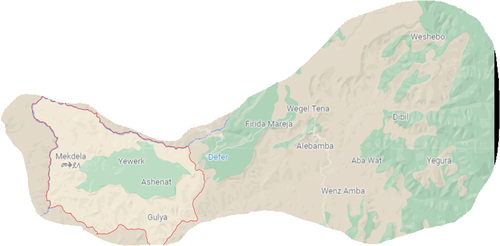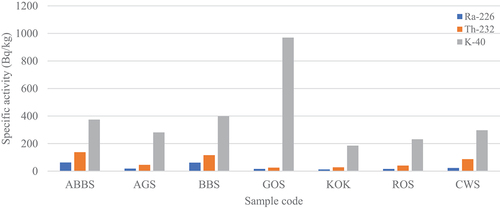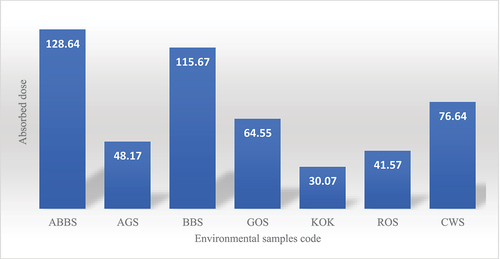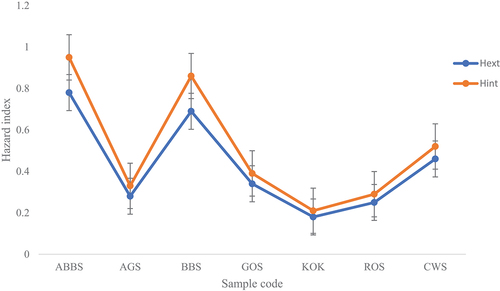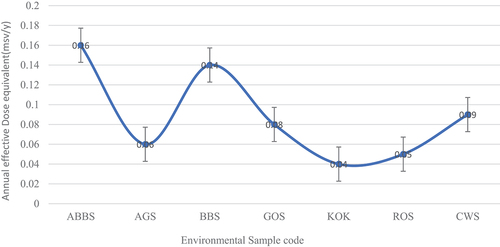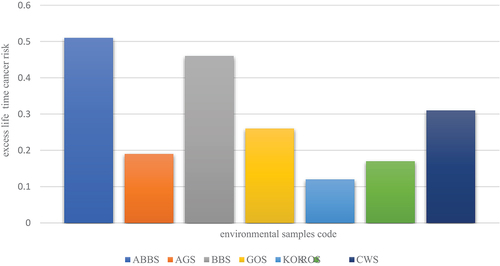 ?Mathematical formulae have been encoded as MathML and are displayed in this HTML version using MathJax in order to improve their display. Uncheck the box to turn MathJax off. This feature requires Javascript. Click on a formula to zoom.
?Mathematical formulae have been encoded as MathML and are displayed in this HTML version using MathJax in order to improve their display. Uncheck the box to turn MathJax off. This feature requires Javascript. Click on a formula to zoom.ABSTRACT
In the Delanta-Dawunt district of Ethiopia’s northern eastern Amhara region, twenty-one different environmental samples (gemstones) were gathered. This is one of the opal-mining (gemstone) locations in Ethiopia. We divided the 21 obtained samples into seven groups. The study’s major goals were to quantify the activity concentration of gemstones (opals) and examine the health implications. For 226Ra, the activity concentration ranged from 11.97 ± 2.46 to 62.44 ± 14.99 Bq kg−1, 25.69 ± 3.69 to 137.84 ± 13.23 Bq kg−1 for 232Th, and 184.84 ± 3.59 to 968.56 ± 18.16 Bq kg−1 for 40K. 226Ra, 232Th, and 40K were found to have mean radioactivity concentrations of 29.84 ± 6.53, 68.44 ± 18.94, and 390.87 ± 6.09 Bq kg−1, respectively. Radium equivalent activity (Raeq), absorbed dose, annual effective dose equivalent, external and internal radiation hazard (Hex and Hin) index, and activity utilisation index have mean values of 151.68 19.46 Bq kg−1, 72.19 8.48 nGy h−1, 0.07 0.01mSv y−1, 0.43, 0.51, 0.57 0.08, and 0.29 0.03. 232Th has higher specific activity than the global average, while 40K has the same. Meanwhile, the absorbed dose is higher than the world’s means value. The average value of excess life cancer risk found in this study is the same as the world’s average value.
1. Introduction
Heat and light are the only types of radiation that people can feel and see, thus they’ve long been regarded as ‘elements’ of the universe. Contrary to popular belief, its primary ‘element’, radioactivity, which produces radiation undetectable to the human eye, was only discovered a century ago [Citation1]. Although radiation has found applications in almost Despite the fact that radiation is used in practically every aspect of human life, the majority of ionising radiation that individuals are exposed to still comes from natural sources [Citation2]. Radiation’s health effects are reasonably well recognised, and they can be effectively mitigated by using proper safety precautions and practices. Radioactivity is a natural aspect of the element production process in stars, where both stable and radioactive isotopes of elements are created. Natural radionuclides emit variable levels of radiation into the earth’s atmosphere and core. Important elements include soil characteristics, geological formations, and human actions that result in radiation emissions. Increasing the amount of natural background radiation [Citation2,Citation3]. Natural radioactivity in soil emits gamma radiation into the atmosphere, altering background radiation levels. These background levels of ionising radiation affect everyone on the planet. Irradiation causes external exposure, while inhalation and ingestion cause internal exposure [Citation3]. Mining and processing of natural resources have had a significant influence on people and the environment [Citation4,Citation5]. Mining operations have been linked to environmental degradation, ecosystem devastation, and general pollution [Citation5,Citation6]. During mining, large volumes of top soil are removed, resulting in a significant amount of mining waste (tailings) with increased radioactivity [Citation7]. Large amounts of mine tailings are disposed of on the surface near the mine, where they are subjected to constant physical, chemical, and biological processes that concentrate radioactivity in the environment, exposing the people to considerable radiation doses [Citation8]. Mine tailings are made up of loose, non-compacted waste that can easily pollute nearby soils due to atmospheric dispersion. The dust particles hanging in the air can potentially be directly ingested, exposing humans to radiation [Citation9,Citation10]. The parameters of nuclear processes that lead to the synthesis of elements define the isotopic composition of elements. Although not yet in chemical equilibrium, the elemental makeup of the planet Earth, estimated to be around 4.5 × 109 years old, reflects the composition of the material from which it was formed. As a result, numerous radionuclides with lengthy half-lives (longer than the age of the world) are found in nature [Citation11]. Ionising radiation can come from a variety of places, including natural sources, nuclear explosions, nuclear power generation, medical, industrial, and research uses of radiation, and radiation-emitting consumer products [Citation12]. Natural (cosmic radiation, radionuclides of the U and Th series, Radon and Thoron, and K-40) and artificial (radionuclides of the U and Th series, Radon and Thoron, and K-40) sources of radiation contribute to this rate (fall-out of nuclear explosions in the earth’s crust, Chernobyl accident, release of radioisotopes in nuclear facilities, use of radioactive sources in industries, and nuclear medicine radiopharmaceuticals) [Citation11]. Most soil and rocks contain traces of 238U, which decays to 226Ra, the parent of 222Rn. The radon concentration in the earth is determined by the radium content of soil and rocks [Citation13–15]. Before calculating the population’s radiation dose, detailed knowledge of the activity of numerous radionuclides is required. Background radiation is made up of radioactive nuclei found in the air, soil, and water, either naturally or as a result of human activities. According to UNSCEAR estimates, the global average human exposure to natural radiation sources is 2.4 mSv y-1, with terrestrial and cosmic sources accounting for 82% of this amount [Citation15]. Furthermore, radiation resides everywhere on the earth’s surface, and natural background radiation exposure accounts for the majority of overall radiation exposure for most humans. The assessment of gamma radiation dosage from natural sources is important since natural radiation is the primary contributor to non-internal dose globally. Radionuclide activity concentrations in the environment vary with geological formation; radionuclides in rocks are quickly mobilised into the environment by natural and human activities [Citation16]. The main objective of this research is to determine the concentration of natural radioactivity and assess the level of index of the hazards of such radiation. This study is the first of its kind in this field in the northern part of Ethiopia, and it serves as a baseline for natural radiation levels in Ethiopia. International researchers will use this data to compare the increase in radiation levels in each year and in other East African countries. This research area has an interest in mining (opal) exploration and has a large deposit of monazite sand. Because of this, the exposure of the public to radiation should be monitored and assessed regularly.
2. Methodology and method
2.1. Geological information of the study
Delanta-Dawunt is one of the potential areas for mining exploration in the Amhara Region of Ethiopia. Its geographical coordinates are 11° 10ʹ 0” north, 39° 29ʹ0” east at an altitude of 3004.00 m and 11°27ʹ36” with an altitude of 2695.00 m respectively. Hydrophane Opal is a fresh word designed to define a specific Opal form. Opals have been mined for thousands of years in Europe and more than 165 years in Australia. However, the finding of opals from Ethiopia and Hydrophane has been around for only about 20 years. Due to this, human beings are more eager to extract it manually without considering the radiation exposure it exposes them to.
2.2. Sample collection and preparation
Using gamma-ray spectroscopy and an HPGe detector, the natural radioactivity levels in gemstone soil samples from the Delant-Dawunt areas are determined in this paper. The twenty-one soil and rock samples for each gemstone were taken from various locations and carefully cleansed of debris, organic residue, and stone shards to a depth of a few centimetres. Each gemstone soil and rock sample were placed in a plastic bag and identified with the sampling area’s geographic coordinates. In the polymer laboratory at Addis Ababa University, the collected gemstone soil/rock samples were weighed and dried for 24 hours in an oven at 105°C. The dried material was next crushed in an automatic grinder in this university’s geology laboratory. The soil/rock sample was then sieved with a 0.25 mm screen to maintain consistent grain size and generate a fine-grained homogenous gemstones soil/rock sample for measurements. About 500 g of homogenised gemstone soil/rock samples were packaged and sealed in an airtight Marinelli beaker and held for one month to achieve secular equilibrium among the 226Ra daughter products and their short-lived decay products. The Ethiopian Radiation Protection Agency laboratory performed the gamma analysis.
2.3. Calibration and gamma spectrometry measurements
For the 1332 keV gamma-ray line of 60Co, the gamma-ray system (Canberra coaxial hyper pure germanium detector) has a photopeak efficiency of 30% and an energy resolution of 1.8 keV full-width at half maximum (FWHM). The sample geometry of Marinelli beaker 538 G-E was used in this research. The copper graded liner of a model B13010 detector was 0.040 in and 0.062 in to prevent interference from lead X-rays. The spectra were analysed using Genie 2000 software from Canberra and detector operating voltages of roughly 3499 V. The spectrometer was calibrated with the use of standard point sources (60Co, 137Cs) according to ISO 9001 is a quality standard to calibrate the detector. The ISO/IEC 17025 quality standard is used to calibrate laboratories to ensure they produce valid results. To remove the background, an empty bottle with the same dimensions was measured. The gamma spectrum with good statistics took roughly 28,800 seconds to count. The concentration of the 238U/226Ra series was determined using gamma-ray transitions with energies of 295.21 and 351.92 keV (214Pb), 609.31 keV, 1120.29 keV, and 1764.49 keV (214Bi). The concentration of the (232Th) series was determined using gamma-ray transitions with energies of 338.4 keV, 911.21 keV, and 968.97 keV (228Ac), 583.3 keV (208Tl) [Citation17]. The concentration of 40K in various materials was determined using the 1460.81 keV gamma-ray transitions 40K [Citation18]. The detection limit of the detector system for 40K, 226Ra, and 232Th is 9.35, 2.07, and 2.58 Bq kg−1, respectively. The gamma spectrum for each sample was done three times, and the average values of the measurements were used to determine the specific activity of the radium, thorium, and potassium elements from their daughter elements with different energy ranges as mentioned above. The photo peak efficacy of 226Ra, 232Th, and 40K were used for this detector, and they were 4.77 × 10−2, 2.97 × 10−2, and 2 × 10−2 respectively.
2.3.1. Statistical analysis
Microsoft Excel 2016 was used to perform multivariate statistical analysis between natural radionuclides and computed radiological hazard parameters of gemstone samples. Descriptive statistics and person correlation analysis were done.
2.3.2. Radiological parameters
shows the calculated activity of thorium, uranium, and potassium in 8 sites collected in Delanta-dawunt on various lithological units of the study (sample area). Although the most notable gamma-ray energy peak, discovered to correspond to 232Th, was found in the collected samples of such radionuclides, they primarily belong to the 232Th, 238U/226Ra, and 235Fe decay series.
2.4. Natural radionuclides in environmental samples
EquationEquation (1)(1)
(1) uses the dry weight of the samples, the net counts (Nc), detector photo-peak efficiency (
) of the peak under consideration, the probability of the radionuclide of interest transitioning at the respective gamma energy (
), the mass (m) of the sample in kg, and the sample counting time (s). NORM activity could be expressed in terms of its unique activity.
(Bq kg−1) [Citation19–22].
The calculated specific activity of 232Th, 226Ra, and 40K are indicated in .
Table 1. Results of specific activity, radium equivalent activity, and radiological hazards in different soil and rock samples of the Delanta-Dawunt area.
2.4.1. Radium equivalent activity (Raeq)
The exposure due to gamma radiation is usually defined in terms of radium equivalent activity Raeq is given by Equationequation (2)(2)
(2) [Citation23,Citation24]
The above equation is based on the assumption 370 Bq kg−1 of 226Ra, 259 Bq kg−1 of 232Th, 4810 Bq kg−1 of 40K produce the same gamma-ray dose rate. The external gamma dosage from radon and its progeny is connected to the internal alpha dose. The maximum allowable radium equivalent activity value is 370 Bq kg-1, which translates to an effective dosage of 1mSv yr-1 for the dwelling’s occupants [Citation15].
2.4.2. Dose rate and annual outdoor effective dose
For terrestrial gamma radiation at a height of roughly 1m above the ground, the external absorbed dose rate (D) in the air is defined [Citation25].
The absorbed dosage for gemstone soil and rock samples varied from 30.08 3.66 to 128.64 14.89 in the current investigation, with a mean value of 72.19 8.48, which is greater than the world means value of 57nGy/h [Citation26].
2.4.3. Annual outdoor effective dose (AEDE)
The average outdoor conversion coefficient from absorbed dose rate in the air and the environmental gamma dose conversion factor (CF) of 0.7 Sv/Gy to convert the absorbed dose ratio to the annual effective dose equivalent can be used to estimate the concentrations of radionuclides in the environment due to terrestrial gamma radiation from 238U/226Ra, 232Th, and 40K [Citation17]. Furthermore, when a person spent 20% of their time outside, the outdoor occupancy factor (OOF) 0.2 and the time was exposed to gamma rays during a year (T) is 8760 h/y [Citation27–29].
The yearly effective dosage corresponding to outdoor terrestrial gamma radiation is 70 Sv y−1). From , the annual effective dose equivalent (mSvy−1) ranges from 0.04 ± 0.01 to 0.16 ± 0.01 with a mean value of 0.07 ± 0.01 mSvy−1. It is the same as the world average value [Citation18].
2.4.4. External Hazard Index (Hex)
The external radiation hazard index is calculated on the assumption that natural radionuclide radiation exposure should not exceed the permitted dose equivalent limit [Citation16, Citation30, and Citation31].
To reduce the radiation risk to a minimum, the value of this index must be smaller than unity. The main goal of this index is to keep the radiation dose below the recognised limit of 1mSv/y [Citation32].
2.4.5. Internal hazard index (Hint)
To reduce the radiation risk to a minimum, the value of this index must be smaller than unity. The main goal of this index is to keep the radiation dose below the recognised limit of 1 mSv/y [Citation32].
For the safe use of certain building materials in the construction of dwellings, the index (Hint) should less than unity.
External ( level index (
This index is also known as a representative level index and was calculated from the following relation [Citation33,Citation34]
The OECD group of experts suggested some criteria for a definition of different levels of to be (representative, first enhanced, secondly enhanced).
as an upper limit,
corresponds to 0.3mSv/y,
corresponds to 1 mSv/y.
Internal (aradioactivity)level index
The excess alpha radiation due to radon inhalation originating from building materials is estimated using the relation below [Citation35]
It should be lower than the maximum permissible value of
, which corresponding to 200Bqkg−1.
For alpha radiation and taking into consideration that a building material with 226Ra concentration less low than 200 Bqkg−1 could not cause indoor radon concentration [Citation17].
2.4.6. Excess lifetime cancer risk (ELCR)
The AEDE stands for annual effective dose equivalent, average life expectancy of DL (average 67 years), and the risk factor for RF, as well as stochastic effects, ICRP risk factors for lethal cancer in the whole population (1/Sv), RF ICRP 103, BEIR VII [Citation36] (NRC, 2006), and ICRP 60, 0.057, 0.064, and 0.072 [Citation17,Citation18].
The annual effective dose equivalent (AEDE), the average life expectancy of DL (average 67 years), and the risk factor for RF, ICRP risk factors for lethal cancer in the whole population (1/Sv), RF = 0.072 are considered according to ICRP 60 [Citation18].
3. Results and discussion
show the activity of 226Ra, 232Th, and 40K radionuclides in gemstone rock/soil samples from eight Delanta-Dawunt locations, while indicates the activity concentrations of 226Ra, 232Th, and 40K, respectively. The measured activity of 226Ra in gemstone rock/ earth samples ranged from 11.97 ± 2.46 to 62.44 ± 14.99 Bq kg−1, with an average value of 29.84 ± 6.53 Bq kg−1, which is lower than the global average values.
The sample of code KOK yielded the lowest value of 226Ra, whereas the sample of code ABBS yielded the highest. The variations are due to the geochemical composition and origin of gemstone soil types in a given region. The concentration of 232Th in gemstone rock/soil samples ranged from 25.69 ± 3.69 to 137.84 ± 13.23 Bq kg−1, with an average of 68.44 ± 18.94 Bq kg−1, which was higher than the global average. The sample code of ABBS yielded the highest value, whereas sample code of GOS yielded the lowest. In all of the samples, the disparities are substantial. The activity concentration of 40K ranged between 184.8 ± 3.59 and 969.59 ± 18.16 Bq kg−1, with an average of 390.87 ± 6.09 Bq kg−1, which is similar to the global average.
Apart from the gemstones (opals), these variances can also be attributed to differences in gemstone soil types in the investigated region. Furthermore, the average values we obtained are within the range of corresponding global values as well as other published data [Citation15] listed in . The activity concentrations for 226Ra, 232Th, and 40K for the analysed sites are higher than the published international radioactivity levels, according to the observed results in some samples. Spain [Citation20], Cyprus [Citation37], Qatar [Citation21], Nigeria [Citation16], Turkey [Citation27], Ethiopia [Citation38], and India [Citation33] all had higher 226Ra activity than in this study. As demonstrated in , our findings had less 226Ra activity than Ghana [Citation19], Ethiopia [Citation39], Brazil [Citation25], Iraq [Citation2], Turkey [Citation28], Malaysia [Citation30], and Nigeria [Citation12]. In this research finding, the activity of 232Th is higher than the global average values [Citation15], Spain [Citation20], Cyprus [Citation37], Qatar [Citation21], Nigeria [Citation16], Turkey [Citation27], Ethiopia [Citation38], Ghana [Citation19], Turkey [Citation28], Ethiopia [Citation39], Iraq [Citation24], and India [Citation33]. As demonstrated in , our findings had less 232Th activity than [Citation25,Citation30], and [Citation12].
Table 2. Comparison of activity concentration and radium equivalent of different samples from different countries of the world.
In this study, the activity of 40K outperformed Qatar [Citation21], Nigeria [Citation16], Turkey [Citation27], Ethiopia [Citation39], and Iraq [Citation24]. As demonstrated in , 40K activity had fewer than Brazil [Citation25], Malaysia [Citation30], Ghana [Citation19], India [Citation33], Ethiopia [Citation38], Nigeria [Citation12], Turkey [Citation28], Spain [Citation20], and Cyprus [Citation37]. The variation in radioactivity concentrations in soil/rock in various areas across the world is influenced by geographical and geological factors. The Raeq for gemstones in rock/soil samples ranged from 65.26 ± 8.36 Bq kg−1 to 262.44 ± 34.36 Bq kg−1, with a mean of 151.68 ± 19.46 Bq kg−1 as shown in . The radium equivalent activity value for all of the soil samples studied is well within and less than the allowed limits of 370 Bq kg−1 [Citation23]. The average absorbed dose rate was 72.19 ± 8.48 nGy h−1, with a range of 30.08 ± 3.66 to 128.64 ± 14.89 nGy h−1 as shown in and . Some of the readings are greater than the suggested international norm of 57 nGy h−1 [Citation26]. As shown in and , external hazard indexes (Hex) ranged from 0.18 to 0.78, with an average of 0.43, while interior hazard indexes (Hint) ranged from 0.21 to 0.95, with an average of 0.51, as shown in and . The calculated Iγ values for all of the samples. With an average of 0.57 ± 0.08, the values varied from 0.24 ± 0.03 to 1.02 ± 0.12 as shown in . and show the calculated outdoor AEDE values. Outdoor effective doses ranged from 0.04 ± 0.01 to 0.16 ± 0.01 mSvy−1, with an average value of 0.07 ± 0.01 mSvy−1. As shown in , the ABBS sample code had higher gamma index values than the world means values. The KOK sample code has a lower risk factor than the other gemstone samples assessed in this study. The KOK sample code had lower alpha index values, while the ABBS sample code had higher values that were lower than the world’s recommended mean values. Pearson correlation analysis was used to examine the relationship and strength of link between numerous radiological parameters and radionuclides. shows a strong positive and statistically significant correlation coefficient of (r = 0.94), which is close to unity, between 226Ra and 232Th. Because the radium and thorium decay series occur simultaneously in nature, Furthermore, all of the calculated radiological characteristics have a direct link with 226Ra and 232Th, presumably because the gemstone rock is rich in 226Ra and 232Th, which play an important role in determining the dangerous nature of such materials. Furthermore, a lesser but statistically significant connection was discovered between these two radionuclides with 40K as shown in . The excess life cancer risk of several gemstone samples was evaluated, as indicated in . The higher values were discovered in the ABBS sample code, which is 1.76 times higher than the global average. The KOK sample code has a lower risk factor than the other gemstone samples evaluated in this study. As shown in and , the mean value of excess life cancer risk is 0.29 ± 0.03 × 10−3 from such environmental samples (gemstone soil/rock), which is the same as the world’s acceptable values [Citation17,Citation35,Citation40]. P-values are used to understand the statistical significance of a finding. In this research, as shown in , the higher P-values were found in the correlation of Ra-Th (0.0.0016). However, for the Ra-K and Th-K, there is a null hypothesis because the p values were lower than zero. The Pearson correlation of 226Ra and 232Th were found 0.94 as shown in in this research which tells strong correlation between radium and thorium isotopes. The correlation between 226Ra with 40K and 232Th with 40K is very low.
Table 3. Pearson correlation of the three natural radionuclide of different gemstones samples.
Table 4. Result of radiological hazards index for different soil and rock samples of Delanta-Dawunt.
Table 5. P values test for correlation corresponding to the three natural radionuclides of the gemstone’s samples.
4. Conclusion
The activity concentrations of natural radionuclides created in the decay series of 232Th, 226Ra, and 40K in gemstone soil/rock samples obtained in the Delanta-Dawunt, wollo district, Ethiopia were used in this study. The computed mean value of 226Ra is lower than worldwide averages but greater than regional averages. The 226Ra activity, 232Th concentration, and radiation hazard index values of the ABBS sample code were higher than those of the KOK sample code. On the other side, the value of 40K is equivalent to the global average. These data suggest that the radionuclides found in the gemstone’s soil/rock samples represent no major radiation risks. According to the World Health Organization (WHO), the risk of excess life cancer is 2.9 × 10−3, according to a study conducted by the International Agency for Research on Cancer (IARC) and UNSCEAR. The mean levels in this study were the same as the world’s tolerated mean value, which needs ongoing monitoring.
Availability of data and materials
Additional data are available in the supplementary information file and upon request to the corresponding author.
Author contribution
Mekuanint Lemlem performed the analytic calculations and performed the data analysis and interpretations. Both Mekuanint Lemlem and Ashok.K Chaubey authors contributed to the final version of the manuscript. Ashok.K. Chaubey supervised the project.
Acknowledgments
I would like to thanks the department head of Physics Dr. Teshome, the Geology department head, and Mr. Wendosewens from Geology laboratory AAU, Ethiopian radiation protection agency research laboratory head Mr. Eshitu, and Mrs. Bogalech for their cooperative and helping to do my experimental work. Lastly, I would like to thanks Adama Science and Technology University and Addis Ababa University for supporting my research.
Disclosure statement
No potential conflictof interest was reported by the author(s).
References
- S. Shani Bal, Rad. Eff. Defect Solid. 1 (2018). doi:10.1080/10420150.2018.1462358
- L.C. Sujo, M.E.M. Cabrera, L. Villalba, M.R. Villalobos, E.T. Moye, M.G. Leon, R.G. Tenorio, F.M. Garcia, E.F.H. Peraza and D.S. Aroche, J. Env. Rad. 77, 205 (2004). doi:10.1016/j.jenvrad.2004.03.008.
- J. Singh, H. Singh, B.S. Bajwa and R.G. Sonkawade, J. Env. Rad. 2009. doi:10.1016/j.jenvrad.2008.09.011
- O.S. Ajayi and S.B. Ibikunle, Inter. J. Rad. Res. 11, 271 (2013). doi:10.12691/amp-4-1-3.
- I.G. EIbeanu IGE, J. Envir. Rad. 64 (1), 59 (2002). doi:10.1016/s0265-931x(02)00058-9.
- M.R. Usikalu, O.C. Anoka and F.A. Balogun, Arch. Phys. Res. 2 (2), 80 (2011). www.scholarsresearchlibrary.com
- E.M. Pontedeiro, P.F.L. Heilbron and R.M. Cotta, J Hazard. Mater. B139, 563 (2007). doi:10.1016/j.jhazmat.2006.02.063.
- A.S. Aliyu, U. Ibrahim, C.T. Akpa, N.N. Garba and A.T. Ramli, Isot. Environ. Health Stud. 2015, 1. doi:10.1080/10256016.2015.1026339
- M.O. Isinkaye, Radiat. Prot. Environ. 36 (3), 122 (2013). doi:10.4103/0972-0464.137477
- K. Skubacz, B. Michalik and M. Wysocka, Radioprotection 46 (6), S669–S674 (2011). doi:10.1051/radiopro/20116735s
- V. Valković, Radioactivity in the Environment, 1st ed. (Elsevier Science, eBook, 2009). https://www.lehmanns.de/shop/naturwissenschaften/28990797-9780080540245-radioactivity-in-the-environment.
- M.A. Akpanowo, I. Umaru and S. Iyakwari, Afr J. Environ. Sci. Technol. 13 (8), 303 (2019). doi:10.5897/AJEST2019.2691.
- E.M. Souza, Radio. Prot. Dosimetria. 2015, 22780–160.
- UNSCEAR, United Nations Scientific Committee on the Effect of Atomic Radiation. Sources and Effects of Ionizing Radiation. Report to General Assembly, with Scientific Annexes (United Nations, New York, (2000). https://pubmed.ncbi.nlm.nih.gov/11281539/.
- E.O. Joshua, J.A. Ademola, M.A. Akpanowo, O.A. Oyebanjo and D.O. Olorode, Rad. Meas. 44 (4), 401 (2009). doi:10.1016/j.radmeas.2009.04.002.
- L. Tettey-larbi, E.O. Darko, C. Schandorf and A.A. Appiah, SpringerPlus 2, 1 (2013). doi:10.1186/2193-1801-2-157
- UNSCEAR, United Nations Scientific Committee on the Effect of Atomic Radiation. Sources and Effects of Ionizing Radiation. Report to General Assembly, with Scientific Annexes (United Nations, New York(2008). https://www.unscear.org/unscear/en/publications/2008_1.html.
- ICRP, Ann. ICRP. 37(2–4), (2007) https://www.icrp.org/page.asp?id=5.
- S. Salmani-Ghabeshi, M.R. Palomo-Marín, E. Bernalte, F. RuedaHolgado, C. Miro-Rodriguez, F. Cereceda-Balic, X. Fadic, V. Vidal, M. Funes and E. Pinilla-Gil, Environ. Pollut. 218 (322–330), 322 (2016). doi:10.1016/j.envpol.2016.07.007.
- H. Al-Sulaiti, Determination of Natural Radioactivity Levels in the State of Qatar Using High-resolution Gamma-ray Spectrometry. Thesis (Ph.D.) (University of Surrey, 2011). https://ethos.bl.uk/OrderDetails.do?uin=uk.bl.ethos.543271.
- El-Sayed, Studying Naturally Occurring Radionuclides for Some Environmental Samples and Their Hazardous. Thesis (MSc) (Fayoum University, 2014).
- J. Berekt and P.J. Mathew, Health Phys. 48, 87 (1985). doi:10.1097/00004032-198501000-00007.
- H. Ali, A. Taqi, L.A. Aziz Al-Ani, M. Abbas and J. Ali, Radi. Res. Appl. Rese. 9, 337 (2015). doi:10.1016/j.jrras.2016.02.007.
- W. Arafa, J. Envir. Radio. 75, 315 (2004). doi:10.1016/j.jenvrad.2004.01.004.
- M. Karataşlı, S. Turhan, A. Varinlioğlu and Z. Yeğingil, Environ. Forensics 75 (424), 1 (2016). doi:10.1080/15275922.2017.1305012.
- UNSCEAR, United Nations Scientific Committee on the Effect of Atomic Radiation. Sources and Effects of Ionizing Radiation. Report to General Assembly, with Scientific Annexes (United Nations, New York, 1988). https://www.unscear.org/unscear/en/publications/1988.html.
- U. Cevik, N. Damla, B. Koz and S. Kaya, Energy Fuels. 22 (1), 428 (2008). doi:10.1021/ef700374u.
- Z. Hamzah, S. Ahmad, H.M. Noor, D.E. She and T. Malay, J Anal. Sci. 12 (2), 419 (2008). https://www.scirp.org/reference/ReferencesPapers.aspx?ReferenceID=144931.
- A. El-Taher, Rad. Isot. 68 (6), 1189 (2010). doi:10.1016/j.apradiso.2010.11.010.
- E. Svoukis and H. Tsertos, Radiation Protection Dosimetry 123 (3), 384 (2007). doi:10.1093/rpd/ncl159.
- R. Hewammanna, C.S. Sumithrarachchi, P. Mahawatte, H.L. Naayakkara and H.C. Ratnayake, Appl. Rad. Iso. 54 (2), 365 (2001). doi:10.1016/s0969-8043(00)00107-x.
- NEA-OECD, Nuclear Energy Agency, Exposure to Radiation from Natural Radioactivity in Building Materials. Report by NEA Group of Experts (Paris, OECD, 1979). https://www.scirp.org/(S(351jmbntvnsjt1aadkposzje))/reference/referencespapers.aspx?referenceid=2521089.
- R. Veiga, N. Sanches, R.M. Anjos, K. Macarioa, J. Bastosa, M. Iguatemya, J.G. Aguiarb, A.M.A. Santosb, B. Mosqueraa, C. Carvalhoa, M. Baptista Filhoa and N.K. Umisedo, Radiat. Meas. 41 (2), 189 (2006). doi:10.1016/j.radmeas.2005.05.001.
- M.M. El-Galy, A.M. El Mezayn, A.F. Said, A.A.E.L. Mowafy and M.S. Mohamed, J. E. Rad. 99, 1075 (2008). doi:10.24327/ijrsr.2017.0811.1125.
- H. Taskin, M. Karavus, P. Ay, A. Topuzoglu, S. Hidiroglu and G. Karahan, J. Environ. Radioact. 100 (1), 49 (2009). doi:10.1016/j.jenvrad.2008.10.012
- D. Ayalew, B. Sitotaw and E. Mengistu, Rom. J. Biophys. 29 (4), (2019). https://www.rjb.ro/wp-content/uploads/Sitotaw_C_4_F.pdf
- UNSCEAR, United Nations Scientific Committee on the Effect of Atomic Radiation. Sources and Effects of Ionizing Radiation. Report to General Assembly, with Scientific Annexes (United Nations, New York, 2002). https://www.unscear.org/unscear/en/publications/2000_1.html.
- A.K. Hailu Geremew*, Chaubey. Inter. J. Curr. Res 11 (2), 1535 (2019). doi:10.24941/ijcr.34403.02.2019.
- R. Ravisankar, M. Suganya, K. Vanasundari, S. Sivakumar, G. Senthilkumar, J. Chandra Mohan, P. Vijayagopal and B. Venkatraman, Rad. Prot. Env. 35, 172 (2012). doi:10.4103/0972-0464.101710.
- NRC, National Academy of Sciences. National Research Council Committee to Assess Health Risks from Exposure to Low Levels of Ionizing Radiation. Report of VII (2006). https://www.nap.edu/initiative/committee-to-assess-health-risks-from-exposure-to-low-levels-of-ionizing-radiation.

